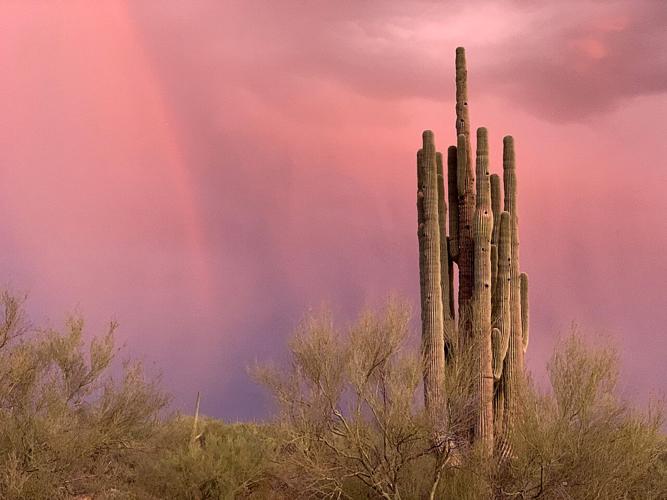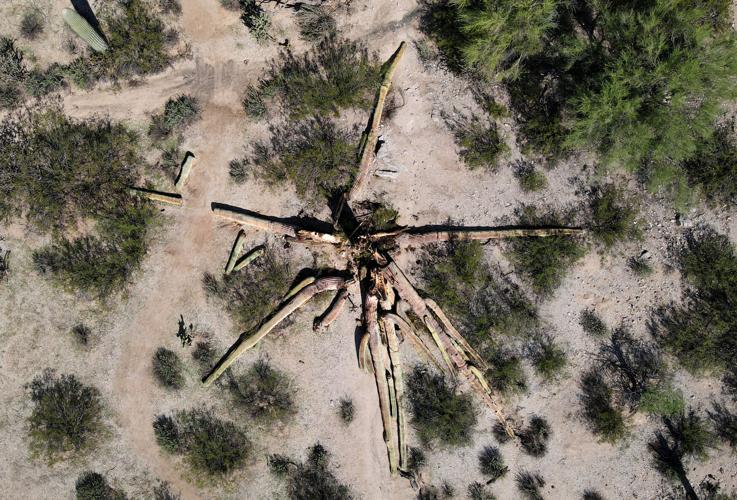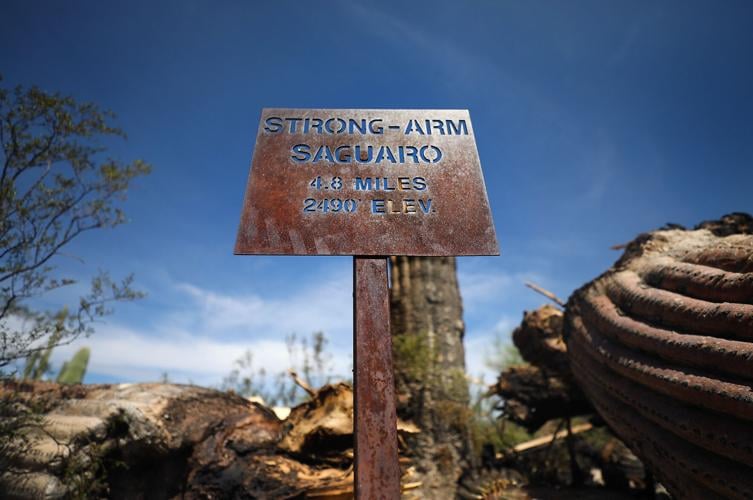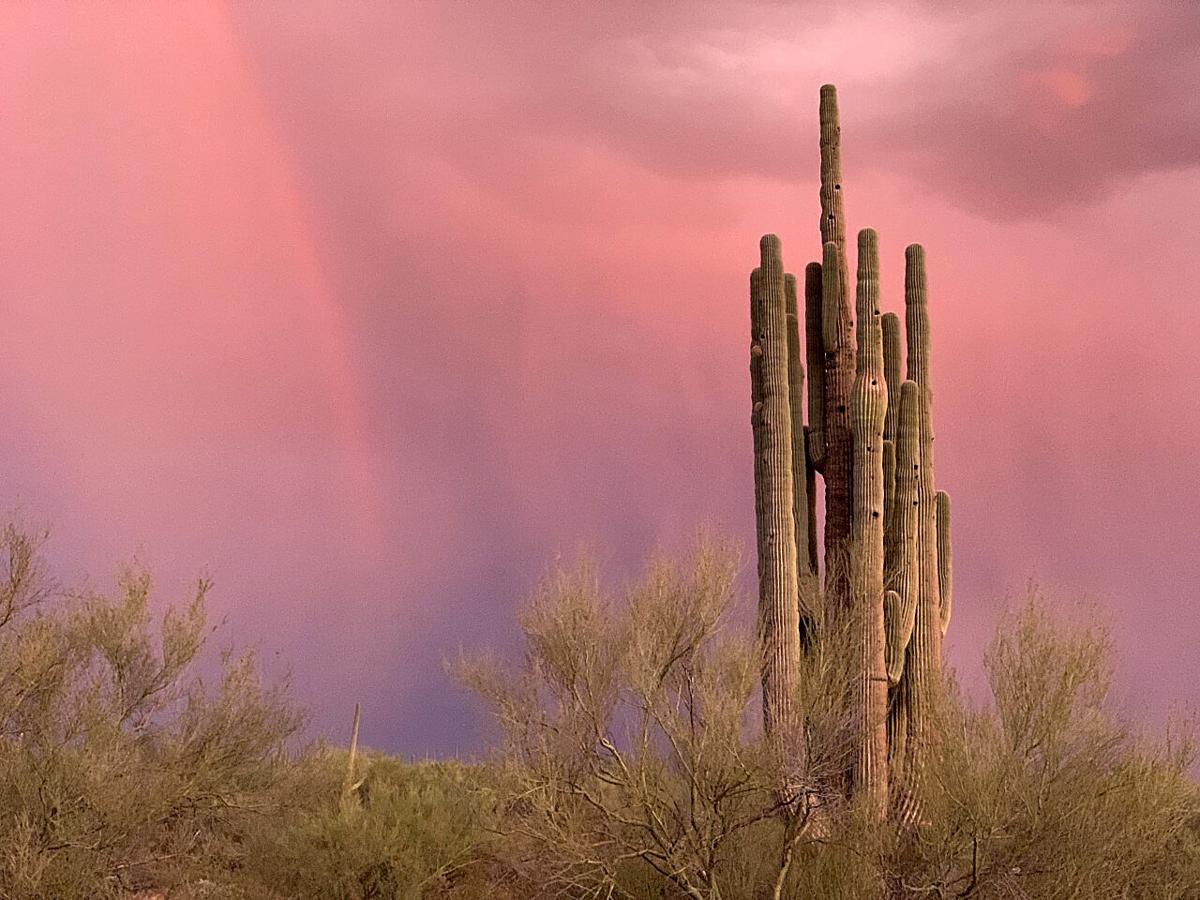Marana has lost one of its oldest and most prominent residents.
A towering saguaro nicknamed Strong-Arm collapsed and died along the trail at the Tortolita Preserve on Aug. 4 after a long bout with a bacterial infection. Its exact age is unknown, but experts believe it was at least 150 years old.
“It was older than the State of Arizona, that’s for sure,” said Jason Grodman, natural resources supervisor for the Marana Parks and Recreation Department.

Drone photo of the Strong-Arm saguaro in the Tortolita Preserve north of Marana, which collapsed on Aug. 4. Strong-Arm was probably 150 to 175 years old, according to Bill Peachey, a Saguaro researcher.
Strong-Arm had its own sign and everything. It was one of several “named” saguaros within the preserve, which sits on 2,400 acres of Arizona State Trust Land that Marana maintains under a 99-year lease.
What made this particular saguaro special was its sheer size and its dense cluster of arms. Mark Johnson once counted 34 of them from his Dove Mountain home that used to look out on the cactus.
He offered his “semi-scientific” — and very specific — estimate for Strong-Arm’s age: 161 years, which would have had it sprouting around the time of Abraham Lincoln’s inauguration and the start of the Civil War.
Johnson is one of the founding members of the Tortolita Alliance, a nonprofit neighborhood group that advocates for the continued protection of the preserve. He announced Strong-Arm’s death in a blog post on the alliance’s webpage a few hours after most of the cactus collapsed.
One long arm and three small ones remained standing until Aug. 6, when they toppled to the ground, leaving only the saguaro’s broken, 8-foot stump.
“Fortunately there are a lot more saguaros out there,” Johnson said. “It’s another good reason why we need to protect that 2,400 acres. We have to give the smaller saguaros a chance to become Strong-Arms.”

Bill Peachey, a Saguaro researcher, gets a closer look at the remains of the famous Strong-Arm saguaro in the Tortolita Preserve.
‘In mourning’
Mark and Kathy Dobbels live two houses down from Johnson. Kathy was startled by the sound of the cactus crashing down at around 4:30 a.m. on Aug. 4, though she did not know what the noise was right away.
“I thought someone was trying to break into the house,” she said.
The Dobbels said a lot of people on their street — themselves included — often took their visiting friends and family members to see Strong-Arm and pose for pictures in front of it.
Kathy broke the bad news to the snowbirds in the neighborhood with a group email that went out to 16 people.
“We’re really in mourning,” she said. “We’ve lost a good friend.”

Strong-Arm saguaro as it looked on Jan. 1, 2021.
Mark said they noticed something wrong with Strong-Arm last summer.
“It just started looking more brown and more brown,” he said. “It’s really sad. (A great-horned) owl family used to make a nest in it every year.”
This was the second big saguaro that has died at their end of the preserve in the past year. Last summer, they lost one even closer to their backyard that they called Pancho.
“What else is there to do in a pandemic when you’re in a lockdown? Name the saguaros behind your house,” Kathy explained.
It’s been a bad couple of years for big cactuses around Tucson, according to saguaro researcher Bill Peachey.
A number of aging giants have been wiped out recently by the cumulative effects of extreme weather events, including freezes, heat waves and powerful wind storms. “It’s happening more often with less time in between, and the plants don’t have time to recover,” he said.
Peachey only needed a few seconds to determine Strong-Arm’s cause of death: The plant was filled with bacterial rot from top to bottom.
“This was in lousy condition when it fell,” he said as he examined the plant on Tuesday. “To have all of those arms infected, this cactus lost the battle some years ago.”
The famous Strong-Arm saguaro in the Tortolita Preserve collapsed Aug. 4. The tall saguaro lived in the Dove Mountain area in Marana. Based on its size and the growth rates of other saguaros in the Tucson area, Strong-Arm was probably 150 to 175 years old, according to Bill Peachey, a saguaro researcher.
Peachey said the cactus was killed by a runaway bacterial infection that probably started several years ago. Video produced by Mamta Popat, Arizona Daily Star. Additional footage by Henry Brean and sunset photo by Mark Johnson.
Very big loss
According to Peachey’s measurements, Strong-Arm stood more than 33 feet tall, with six, closely bunched main stems, each over 20 feet in length. Based on its size and the growth rates of other saguaros in the Tucson area, it was probably somewhere between 150 and 175 years old.
“Long arms is one of the signs of an old, old cactus,” he said.
The saguaro was in such a weakened state that it could have been toppled by almost anything. “A gust of wind could have done it,” Peachey said, “or the weight just got to be too much.”
Whatever the cause, Strong-Arm lived up to its name to the end, he said. “It was riddled with bacteria and at the very edge of death, and it still held its form until the very last moment.”
Its death leaves a hole in the local ecosystem.
For more than a century, the cactus served as both a neighborhood grocery store and an apartment complex for countless desert creatures, including bats, insects and birds such as the now-rare cactus ferruginous pygmy owl. A saguaro this size would have been a “major producer” of nectar, fruit and shelter, Peachey said.
“Where are the woodpeckers going to go? And (without their holes) where are the elf owls and purple martens going to go? There’s a whole cascade of badness that this exemplifies,” he said.

A sign was placed near the Strong-Arm saguaro in the Tortolita Preserve. The famous cactus collapsed Aug. 4.
The initial collapse of the cactus blocked the recreational trail that loops through the preserve, so Marana’s parks department sent a crew out to clear a new path around the downed plant.
Two days later, the last remaining giant arm dropped off, blocking the trail once again. This time, Grodman said, the crew cut a section out of the fallen arm so hikers and mountain-bikers could pass through without slowing down.
But people have been stopping anyway. A handful of people made special trips to the preserve to check out the grisly scene, snap a few pictures and pay their respects.
There has even been some talk among the neighbors and others about holding some kind of ceremony in honor of Strong-Arm.
Grodman said whatever they do should be respectful, particularly to the Tohono O’odham, who think of saguaros as people, the embodiment of their ancestors.
“I don’t want to call it a memorial (service) necessarily,” he said. “Call it a celebration of life.”









